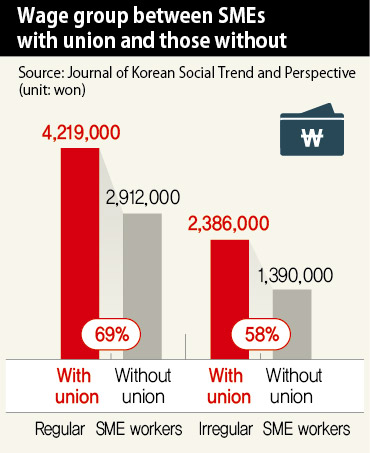 |
|
Wage group between SMEs with union and those without
|
Gap between large corporations with unions and those without relatively small
 |
|
Wage group between SMEs with union and those without
|
The wage gap between large corporations with and without labor unions is relatively small, while wages at small and medium enterprises (SMEs) without unions are 30-40% lower than at those with unions, a research study shows.
According to the findings, wages differ primarily according to regular or irregular worker status and company scale, but the presence of a union also had a highly significant impact on wage levels at SMEs. The findings are drawing attention as an illustrating the limits of converting irregular workers to regular status alone as a means of relieving income inequality.
In the latest issue of the quarterly Journal of Korean Social Trend and Perspective, Jeong Jun-ho, professor of real estate studies at Kangwon National University, and Nam Jong-seok, research professor at Pukyong National University Economy and Social Science Research Center, published a paper titled, “The Effects of Workers’ Combined Labor Market Status on Wage Distribution.” Using data from a 2017 Ministry of Employment and Labor (MOEL) survey of working conditions by employment type, the researchers analyzed average monthly wages for eight groups – based on categories including regular or irregular status, large corporation (300 or more employees) or SMEs, and union presence – along with specially employed workers.
For its survey of working conditions by employment title, MOEL extracts a sample of workplaces every year from among private businesses with one or more workers to examine wages, working hours, and working conditions; the 2017 survey looked at 33,000 workplaces with a combined total of 970,000 workers. The scenario with the highest average monthly wages was a regular employee at a large corporation with a union (5,431,000 won, or US$4,645), followed by a regular employee at a large corporation without a union (5,360,000 won, or US$4,584). Regular positions at large corporations are widely recognized as offering the highest pay levels, but the presence of a union was not found to have a significant impact on wages.
For SMEs, it was a different story. After regular positions at large corporations, the next highest wage levels were found for regular employees of SMEs with unions (4,219,000 won, or US$3,608), followed by a regular employee of an SME without a union (2,912,000 won, or US$2,490). In other words, regular workers at SMEs without a union averaged roughly 1.3 million won (US$1,112) per month less than their counterparts at SMEs with unions, or approximately 69% less.
Additional groups included specially employed workers (2.59 million won, or US$2,215), irregular workers at large corporations with unions (2,421,000 won, or US$2,070), irregular workers at large corporations without unions (2,408,000 won, or US$2,059), irregular workers at SMEs with unions (2,386,000 won, or US$2,040), and irregular workers at SMEs without unions (1,390,000 won, or US$1,189). The same sort of pronounced “union effect” at SMEs was also found among irregular workers, who averaged nearly 1 million won (US$855) less in monthly wages at workplaces without unions – or 58% of what their counterparts at workplaces with unions earned.
“Because SMEs are so vulnerable, the presence of a union has a huge effect in protecting workers and wages,” said Jeong. In terms of the overall wage gap, irregular workers were found to earn roughly half the wages made by regular workers.
With the presence of a union influencing wages in addition to employment type and company size, the researchers voiced concerns that an approach of simply converting irregular workers to regular status or demanding concessions from regular workers could fail to live up to expectations. In the case of SMEs, workplaces without unions outnumbered those with unions by a factor of roughly 10, respectively representing 54.5% and 5.6% of all businesses examined in the study. With the rarity of cases where irregular workers have a union (0.3%, compared to 21.9% with no union), increasing labor organization rates would also have a major impact in terms of increasing wages.
“To achieve the increased wages that are a key component of income-led growth, it’s important to increase workers’ bargaining capabilities,” said Jeong.
“The structure between subcontracting businesses and their employees also need to be improved to yield effects through social solidarity wages, where large corporation unions use a portion of wages to support workers at SMEs,” he suggested.
By Cho Hye-jeong, staff reporter
Please direct comments or questions to [english@hani.co.kr]








